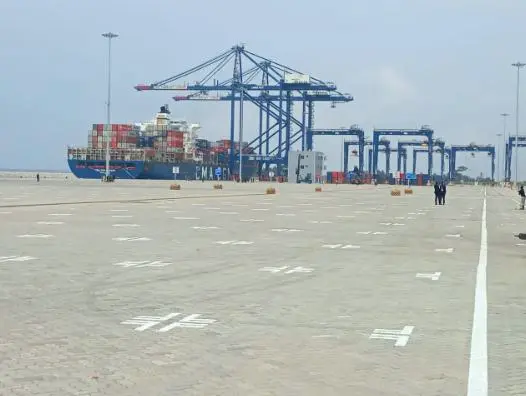The $1.5 billion Lekki Deep Seaport, the first in Nigeria, will be officially opened by President Muhammadu Buhari at any time.
At 1:40 p.m., dignitaries, including members of the diplomatic corps, flocked to the Lekki Deep Sea Port, where President Buhari would be presiding over the launching of other renowned projects in Lagos.
Lai Mohammed, the minister of information and culture, Mohammed Bello Koko, the director general of NIMASA, Bashir Jamoh, and Emmanuel Jime, the executive secretary of the Nigerian Shippers Council are just a few of the dignitaries there.
The Lekki Deep Seaport is anticipated to transform everything in West and Central Africa due to its size and depth.

Other projects that will soon be completed include the John Randle Center for Yoruba Culture and History, the MRS Lubricant Factory in Apapa, and the 18.75 km six-lane rigid-pavement Eleko Junction to Epe Expressway.
Upon arrival, Buhari and Bababjide Sanwo-Olu, the governor of Lagos State, would be driven around the 1.5 km long main of the port.
There is space in the harbour, which spans more than 600 meters, for a ship carrying up to 16,000 standard containers (TEU). The 11 km-long approach channel.
Last year, the Zhen Hua 28 became the first ship to berth in the Lekki Deep Seaport, making history.
The container terminal, the liquid terminal, and the dry bulk terminal are the three terminals at the port.
The container port, according to its promoters, can be progressively dredged to reach a draft of 16.5 meters from its initial draft of 14 meters. The facility has a capacity of 2.5 million 20-foot containers annually.
The first port in Nigeria to have ship-to-shore cranes is the deep-water port of Lekki. It contains three of these “Super-post-Panamax” container gantry cranes, which are able to access and unload the last row of containers even if the container ship is wider than the Panama Canal (49m or 160ft maximum boat beam).
A fixed rail is present at the quayside for the STS cranes. They have a lifting capacity of 50 tons for a single lift, 65 tons for twin lifts, and 85 tons for hook lifts.



